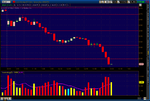malaspina
Active member
- Messages
- 115
- Likes
- 1
What I see here is a chart that over an 8 hour period you have managed to draw 14 horizontal lines.
The chances of a bar with a higher than average volume intersecting one of these lines is obviously high for no reason other than the fact that there's very little chance of any bar not hitting a line.
Why not actually give something substantive on volume analysis.
Mr. DionysusToast, please look closer and think a little bit, use your brain.




